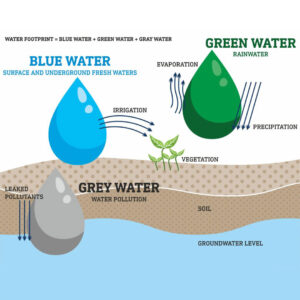Water is an indispensable natural resource for the continuation of vitality. In the absence of water, which has become a strategic resource, or in a world where access to it becomes difficult, the lives of living beings are endangered. In addition, agricultural and industrial activities are becoming unsustainable.
The recent drought, the effects of the increase in greenhouse gases into the atmosphere, global warming, increased water use and water pollution, environmental factors such as the inability of consciousness causes a reduction of the available water resources over time. In addition, water consumption per person is constantly increasing.
Therefore, the measurement of the quantity and quality of water used in production and consumption processes has become important, and in 2002, for the first time, Prof. from the UNESCO-IHE Institute of Water Education. Dr. The concept of ‘water footprint’ was introduced by Arjen Hoekstra.
In short, the ‘water footprint’ is the measurement of the amount of water we use. Water footprint measurement is carried out for every daily or non-daily action and every product, except for activities such as eating, drinking, personal care, cleaning. The water footprint is the total amount of water consumption caused directly or indirectly by a product or service in the process from the initial production stage to the transmission to the end user.
THERE ARE 3 TYPES OF WATER FOOTPRINT;
1- Blue water footprint: it is the total amount of surface or underground fresh water resources used during the production process. These resources are mainly used for agricultural, industrial and domestic purposes.
2- Green water footprint: it is the total amount of rainwater used during the production process. These resources are mainly used in agriculture, horticulture and forestry activities.
3- Gray water footprint: it is the amount of water required to clean the dirty water arising from the production of the product or the supply chain.When these data are examined together, the source of the water used can be determined and a comprehensive assessment of water consumption can be made.
When these data are examined together, the source of the water used can be determined and a comprehensive assessment of water consumption can be made.
For example, about 15,000 liters of water are needed to produce one kilogram of beef ( which is equivalent to leaving a tap on for about 20 hours). Of this, 93% is green, 4% is blue, and 3% is gray water footprint.
Our coffee table to come to us; the cultivation of the coffee plant, making harvesting, refining, transportation, coffee beans packaging, coffee sale, and has gone through the stage of filling the cup of coffee you need full amount of water to 140 liters (our coffee in a paper cup, drink it with milk and sugar if we want to, this amount is 208 liters).

A simple pizza means 1260 liters, a glass of water means 30 liters, and a 100-gram chocolate bar means 1700 liters of water. Although the food sector accounts for the majority of water consumption, everything from the shirt worn to the computer used, from the paper written on it to the energy consumed for heating leaves a footprint in the water.
In today’s conditions where increasing population density and natural resources are insufficient, the size of the water footprint should be learned and tried to reduce it in every area that causes water consumption for a sustainable life.
Priority should be given to making preferences for water saving in daily habits. Choosing a machine instead of washing dishes and laundry by hand, not pouring waste oils into the sink, throwing waste batteries and unused medicines into special collection places instead of in the trash, reducing plastic packaging consumption are also steps that will lead to reducing the water footprint and protecting nature.
In particular, the density of the water footprint is the water consumed in agricultural irrigation. In this context, Atlantis, which has been leading irrigation projects for many years, applies pressurized irrigation systems that will minimize water loss while aiming for maximum efficiency in products and makes a great contribution to water saving.

how to buy androxal uk pharmacy
ordering androxal cost uk
cheapest buy enclomiphene purchase online safely
purchase enclomiphene buy online australia
buy cheap rifaximin canadian online pharmacy
how to order rifaximin uk delivery
order xifaxan buy in australia
buying xifaxan uk buy cheap
buy cheap staxyn australia purchase
purchase staxyn price prescription
BUY avodart COD
online order avodart cheap wholesale
get dutasteride cheap buy online no prescription
order dutasteride canada fast shipping
comprar flexeril cyclobenzaprine en espana
buying flexeril cyclobenzaprine canada drugs
buy gabapentin australia over the counter
how to order gabapentin usa suppliers
purchase fildena generic free shipping
cheap fildena saturday delivery cod
srovnání cen kamagra
kamagra lékárna s nejnižšími náklady
ed meds kamagra
kamagra consultation en ligne fedex cod gratuite
how to order itraconazole uk suppliers
Buy itraconazole online no perscription